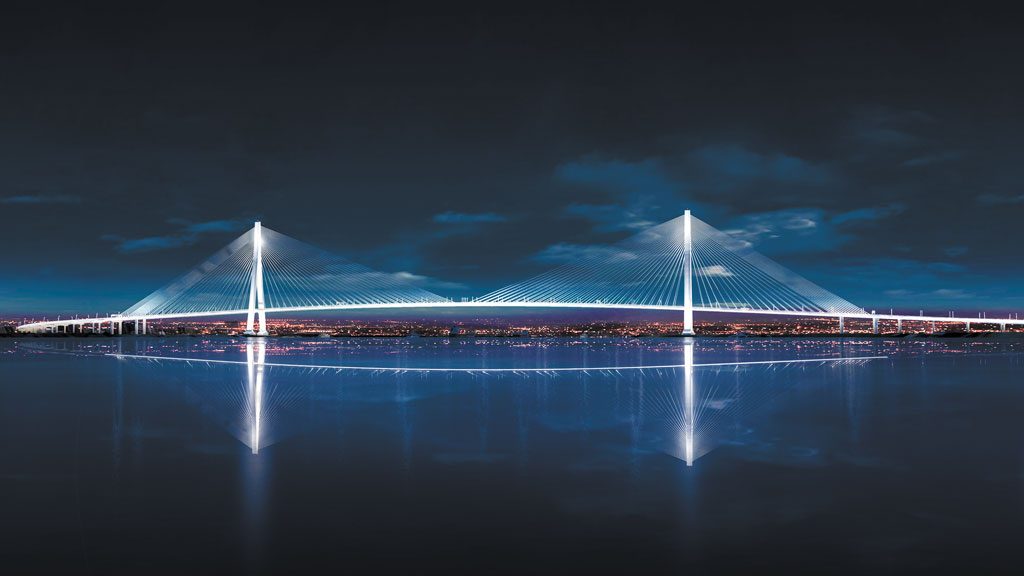The first signs of tangible work on the $5.7 billion Gordie Howe International Bridge itself was unveiled to a group of reporters recently.
Up to now, over the past three years, most of the work has been related to pre-construction or “early work” activities such as site clearing, utility relocation and construction of a perimeter access road around the Canadian Customs plaza and toll facilities, or the so-called Port of Entry (POE).
But, since August, crews from Bridging North America, the international consortium building the P3 bridge for the Canadian government, have begun work on the actual bridge.
In late November, reporters saw the installation of the 11th of 12th shafts that are the footings for the concrete pier caps which will support the two A-frame legs of the cable-stayed bridge on the Canadian side. Similar work is less advanced on the U.S. side in Detroit as land acquisition and preliminary construction is still taking place.
The concrete shafts or caissons form the footings for the two caps and each shaft took about four days to install. There are two groups of six shafts, arranged in a kind of hexagonal pattern six metres apart at the bottom of what will be each pier cap, the two caps to be connected by a tie beam measuring 37m length by 10m width by 1.5m height.
On the media tour, reporters saw the removal of one of about a dozen tools or augers used to cut through the mainly sandstone rock to the competent rock about 30 metres (97 ft. or nine stories) below. Each shaft is three metres in diameter and 37 metres (122 ft.) in length, protruding more than six metres (20 ft.) above ground.
“Every drill shaft is different, every single one, that’s why we have so many tools,” construction lead Terry Poole said, pointing to the nearby line-up of giant tools which alternately are called augers or even huge drill bits.
Poole, originally from Windsor and who has worked on numerous bridge projects including the new Tappan Zee near New York City, said once the soil overburden is removed and the drill reaches bedrock a video camera is dropped “and we look around and make sure the socket is nice and clean.” Then a giant cylindrical rebar cage is inserted.
One of those cages, weighing-in at 165,000 lbs. had arrived just that morning and ironworkers were installing rigging to lift it off a flatbed before two cranes swung it over to the shaft, about 30 metres away.
“They take it off the transports horizontally — the transport trucks will pull out from under it and then they’ll set it down,” Poole said.
It takes about a week to construct the rebar which is inserted into the shafts and then filled with 262,000 litres (69,000 gal) of concrete.
There will also be six shafts on each side for the bridge’s back spans.
The shaft or footings work began in August and is almost finished on the Windsor side. Next up: constructing the pier caps in three lifts with each cap measuring 21m high, 18m in width and 20m in length. That work should be finished by late spring. The caps will be located about 20-30 metres from water’s edge because the bridge direction is slightly angled.
Once the caps are finished the legs of the A-towers will be constructed and finished by 2022.
The legs will be constructed by A-shaped self-climbing framework in 4.7 metre intervals, with 51 jumps before reaching the very top at 220 metres (750 feet).
Meanwhile work is continuing on the POEs where 150,000, 20-metre deep wick drains have been installed on the Canadian side covering an area of 120 hockey rinks. This will be followed by delivery of 200 trucks per days of aggregate. Then the Customs plaza and other buildings will be constructed as bridge work itself proceeds.
Once finished — a November 2025 completion date is targeted — the Gordie Howe will have the longest span (853 metres or 2800 ft.) of any bridge in North America and be the fifth longest cable-stayed span in the world.











Recent Comments
comments for this post are closed